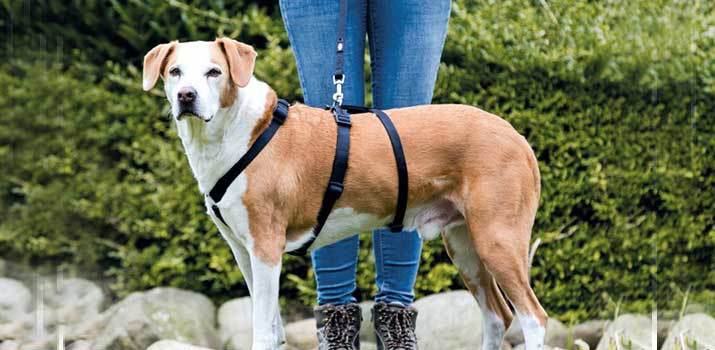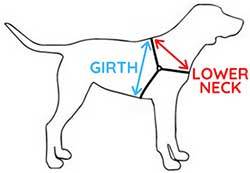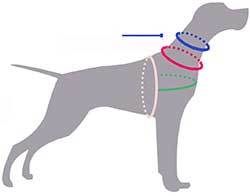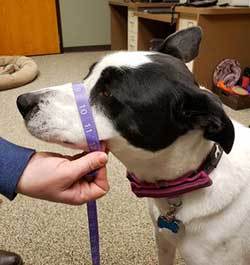Sizing canine gear is easier said than done. When you walk through your local pet store, you're bound to see aisles or harnesses and clothing items in several sizes. Unfortunately, the canine sizing system that many brands use just isn't effective.
A lot of brands base sizes on the weight of the dog. But do you really think that a muscular American Bully is going to fit into the same piece of clothing as a lean Greyhound?
Like humans, dogs come in all shapes and sizes.

Some have stockier builds while others have a slender shape for agility. Meanwhile, several breeds have unique physical quirks that make standard sizing protocols impossible to go off of!
Look at the Dachshund or the Pug! The Dachshund's short legs and the Pug's girthy neck throw all sizing conventions out of the window.
Whether you're looking for a harness, a traditional collar, or a fancy costume for the holiday season, you need to take accurate measurements to get something that fits correctly.
Why is a Snug Fit Important?
Think about the last time you wore an ill-fitting garment! It's not the most comfortable experience, is it?
Getting a dog to wear an accessory is hard enough. When that accessory doesn't fit right, most dogs will get a bit rebellious. They might not listen to your commands or move at all. Some will turn to destructive behavior to take the accessory off.
Beyond the issue of comfort, ill-fitting gear can pose a safety risk, too. For collars, muzzles, and harnesses, the fit is crucial. Get a harness that's too small and you run the risk of your dog wiggling his or her way out.
Invest in an accessory that's too small and your dog can end up injuring their neck. They could even have difficulties breathing.
It's not just poorly fitted containment gear that's the problem. Tight clothing can compress your dog's lungs or strangle their neck.
Needless to say, accurate measurements are a must.
Want to know how to measure your dog for a harness, coat, sweater, collar, or muzzle? Whip out your flexible tape measure and record the following parameters.
How To Measure a Dog the Right Way
Lower Neck Girth
Generally, you will only see broad measurements for the neck. That's because most collars are designed to fit on a specific point around your dog's neck. But sweaters and coats? They usually sit a bit lower.

To get a snug fit, you'll need to measure the lower part of your dog's neck.
As a good rule of thumb, use the withers as a guide. This is the ridge between your dog's shoulder blades.
Have your dog stand up and wrap your tape measure around the entire neck at the withers. Now, use your fingers to provide a bit of extra wiggle room. Simply mark the final girth measurement, place two fingers at that point, and record the new number.
This second number with the extra finger space is the one you want to use when finding clothing. Some sweaters don't have elastic material around the neck hole, so having that extra wiggle room is essential.
Upper Neck Girth
Collars and bandanas generally sit a bit higher up on the neck than clothing or harnesses. So, you might want to get a new measurement to reflect that position.
You could use the same lower neck measurement at the withers when looking for collars. But, you run the risk of getting something too big. You don't want your dog's head to slip out, so it's always good to take a second measurement just in case.

Find the halfway point between the withers and the back of the ears. There's no exact science when it comes to finding the right spot for a collar to sit. Oftentimes, collars will slide up and down anyways, so you don't have to be super exact.
Once again, wrap the measuring tape around your dog's upper neck and record your measurement.
Use this figure to find a collar or bandana. Don't add the extra two-finger measurement as you did for the lower neck. You'll take that wiggle room into consideration when you put the collar on and adjust its tightness.
Topline
The topline refers to the dog's length. It's the distance between the withers and the base of the tail.
In most cases, there's a lot of leeway with the topline. What's right for your dog will depend entirely on your needs! Most harnesses don't extend down to the base of the tail. Neither do most garments on the market.
That said, it is good to understand this measurement for future reference.
Chest Girth
Finally, there's the chest girth. This is a very important measurement to take because it affects your dog's ability to breathe. You want to pay special attention and take some extra time to get an accurate measurement.
To figure out the chest girth, you want to wrap the tape around the widest part of your dog's chest. This is usually just behind your dog's arms. You can tuck the tape in their "armpits" on their front legs. The top of their body won't be at the withers.
Take a couple of measurements for accuracy to be on the safe size.
How Do These Sizes Relate to Clothing and Accessories?
Brands will often use those core measurements as a guide. Then, they'll create small, medium, large, and extra-large sizing.
Don't take the basic word sizes at face value! Take a look at the specific measurement ranges and choose one that's appropriate for your pooch. Chances are, the accessory will have some adjustment to get things just right.
What About Face Muzzles?

Sizing a muzzle is a bit different. Because these accessories only wrap around the face, you want to take two measurements. These include the girth of the snout and the length of the snout.
Wrap the measuring tape around the widest point of the snout. This will be just below the eyes. Again, take a couple of measurements for accuracy.
For the length of the snout, measure from the base of the eyes all the way down to the tip of their nose.
Fitting a muzzle correctly can be tricky. To be on the safe side, get a model that has ample adjustments to make things easier.
Conclusion
Once you have all of your dog's measurements, shopping for accessories should be a breeze! Never rely on simple sizing. All dogs are different, so you want to get something that you can easily adjust.
Take some time to find a well-fitted garment and your dog won't have any issues wearing it.

